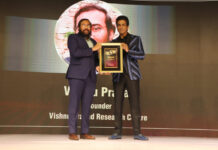New Delhi: According to the United Nations Environment Program (UNEP), buildings around the globe account for 36 percent of energy use and 39 percent of energy-related carbon dioxide emissions annually. Researchers at Indian Institute of Technology (IIT), Guwahati develop smart window materials for automatic climate control of buildings. These materials can be helpful in designing smart climate control systems in buildings to save energy and reduce carbon emissions.
Newly designed smart window material can effectively control the amount of heat and light passing through it in response to an applied voltage. Such smart window materials would help developing efficient automatic climate control systems in buildings, researchers said. The results of their study have recently been published in the journal, Solar Energy Materials and Solar Cells.
The primary consumption of energy in buildings is by the climate control system, in which energy-consuming devices are used to maintain comfortable indoor temperature and brightness. Hence, a building’s heating, cooling, and lighting loads are major energy-consumption segments in any building. To meet the goals of the Paris Climate Agreement, a building’s energy intensity— how much energy buildings use—will have to improve by 30 percent by 2030.

“There has been increased attention to sustainable architectural designs for better light and heat management in buildings in recent years, and deploying smart windows is the first step for such structures”, said Dr. Debabrata Sikdar, Assistant Professor, Department of Electronics and Electrical Engineering, IIT Guwahati. Conventionally, window designs are static, i.e., they are predesigned for specific climatic conditions. The emergent smart windows, on the other hand, can dynamically adjust the amount of light and heat radiation entering a building in response to external stimuli, thus conserving the building’s energy.
The design of smart windows that are tuneable for all-weather conditions is challenging. The IIT Guwahati team has designed smart window ‘glasses’ using noble metals as well as their relatively inexpensive alternatives that can dynamically control the intensity of transmitted solar radiation, depending upon the weather/climate condition.
“We have proposed an electro-tuneable glass made of two ultra-thin metal layers sandwiching an electro-optic polymer whose refractive index can be changed by applying a small voltage, which allows filtering of visible and infrared radiation,” explained Mr. Ashish Kumar Chowdhary, Research Scholar, IIT Guwahati.
The researchers used this design to perform simulation studies to understand the light and heat transmission properties in response to the applied voltage. They initially considered gold and silver as the metal layers, but later tested their model with cheaper alternatives such as copper, and transparent semiconductor such as indium tin oxide.
When the researchers simulated the application of a bias voltage ranging from −15 V to +15 V across this sandwich structure using Finite Element Methods, the smart glass could selectively filter solar radiation, spanning the visible, infrared and shortwave infrared wavelengths. Simulation also showed that this material reflected mid-wave infrared, long-wave infrared (LWIR; 8–15 μm), and a part of far-infrared wavelengths thereby providing insulation from heat and light reflected from neighbouring buildings and structures.
” We believe that our smart windows can provide an alternative solution for maintaining ambient indoor temperature and lighting inside a building or a vehicle by integrating those with usual glass windows or walls, thereby reducing the need of air-conditioning systems ” said Dr. Debabrata Sikdar.
These smart glasses can find applications for efficient automatic climate control in vehicles, locomotives, airplanes and greenhouses of the future. The smart glass material proposed by the IIT Guwahati team can easily be fabricated using existing state-of-the-art nanoscale fabrication methods such as e-beam evaporation and graphoepitaxy techniques. (India Science Wire)











